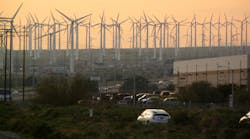In addition to helping drivers save money, the app aligned EV charging with low-carbon electricity, supported grid reliability by avoiding charging during peak times and charged vehicles fully by the time drivers needed them.
The first customer cohort produced successful results, shifting 93% of EV electricity usage away from the 4 p.m. to 9 p.m. peak, reducing carbon intensity by 55% on average and saving EV2 rate customers around $12/month before event-based incentives. On a household basis, the average load reduction during the 4 p.m. to 9 p.m. peak was 12.4%, with solar customers having an average of 21.9% peak load reduction and non-solar customers 3.6%.
In addition, participants were encouraged to take advantage of low-carbon events when solar energy generation was particularly high. Customers got push notifications on their mobile phones 24 hours in advance of a low-carbon event. The notification nudged them to avoid charging overnight and instead plug in during daytime hours, if possible, to charge with abundant solar. During the pilot period, 90% of customers participated in at least one event, enabling MCE Sync to shift approximately 50% of the overnight load into daytime windows with up to 80% lower-carbon electricity.
Key Learnings
The pilot program provided insight into new strategies for electric service providers and the EV charging market as a whole.
Electricity providers should consider these learnings:
- TOU rates alone are not enough to successfully address grid reliability and carbon concerns. The app was able to smooth out rebound timer peaks and align with day-ahead emissions.
- An emphasis on equity. Pilots should represent the customer service area so they scale effectively into programs.
- Provide locally relevant messaging to participants with trusted partners, translate content for non- English speaking audiences, and add incentives for low-income customers.
- New programs should align with existing programs. MCE Sync participants were auto-enrolled by ev.energy into MCE’s demand response market as well, which triggered additional events that increased the benefit to customers.
The EV charging market should consider these learnings:
- Nudges work. Combining behavioral economics with active load control provides the best load-shifting results compared to each program on its own.
- Vehicle application programming interfaces (APIs) should be open to all. Auto manufacturers should make their telematics platforms reliable and open to enable
customers to enroll in vehicle-to-grid integration programs. - Third-party evaluation is necessary. Third-party evaluation can help to quantify the impacts and distill lessons from pilot phases into strategies for program enhancement and scaling.
Based on these learnings, MCE and ev.energy determined that increasing customer incentives and education could further reduce grid strain by emphasizing the benefits of the charging program. When drivers better understand the benefits, they are more likely to schedule their charging times outside of peak hours and may even change their behavior to receive greater financial incentives. Additionally, aligning charging with rooftop solar generation could further reduce customer bills.
The Bottom Line
MCE and ev.energy announced the expansion of the MCE Sync program in June 2022. The expanded program continues to offer incentives that reduce the cost of EV charging at home and increases community resiliency with a focus on low- to moderate-income populations. MCE’s goal is to have around 4.000 EV drivers enrolled in its program by May 2023.
MCE Sync now offers additional benefits, including EV charging aligned with home rooftop solar generation and grid solar availability, grid-reliability incentive payments worth up to $10/month and customer education about smarter charging strategies.
The EV market is growing approximately 40% to 80% each year, according to Virta Global. With EVs expected to comprise one-half of U.S. auto sales by 2030, utilities need to treat EVs like they would treat any other distributed energy resource and find ways to best manage the energy load. That is the only way to nip grid strain in the bud to future-proof energy systems now.
And with ZEV states leading to limit new car sales to EV-only after 2035, the time to start planning for the massive wave of EVs connecting to grids is now. If utilities can make better use of the distribution, they can eliminate the challenges of strain and usage.
Brett Wiley ([email protected]) managed MCE’s EV charging infrastructure, EV rebate, managed home EV charging and fleet electrification programs for nearly five years. He currently manages East Bay Community Energy’s residential electric mobility programs. Some of his other prior work experiences were at Groundswell, Sierra Club, National Park Service, and The White House Council on Environmental Quality. Wiley received his B.S. in Biology from Truman State University, his MPA in Energy & Sustainable Development from Indiana University’s School of Public and Environmental Affairs (SPEA), and his Certificate in Social Entrepreneurship from SPEA and Indiana University’s Kelley School of Business. He is also an Adjunct Professor at Presidio Graduate School.
Joseph Vellone ([email protected]) is head of North America at ev.energy. In this role, he partners with energy providers such as MCE and National Grid, manufacturers such as Volkswagen and Siemens, and charging networks such as ChargePoint and Volta to deliver greener, cheaper, grid-friendly EV charging to drivers across the U.S. and Canada. He previously spent five years with the Boston Consulting Group’s energy and environment practice. He holds a master’s degree in energy economics from the London School of Economics and a bachelor’s degree in public policy from Princeton University.




